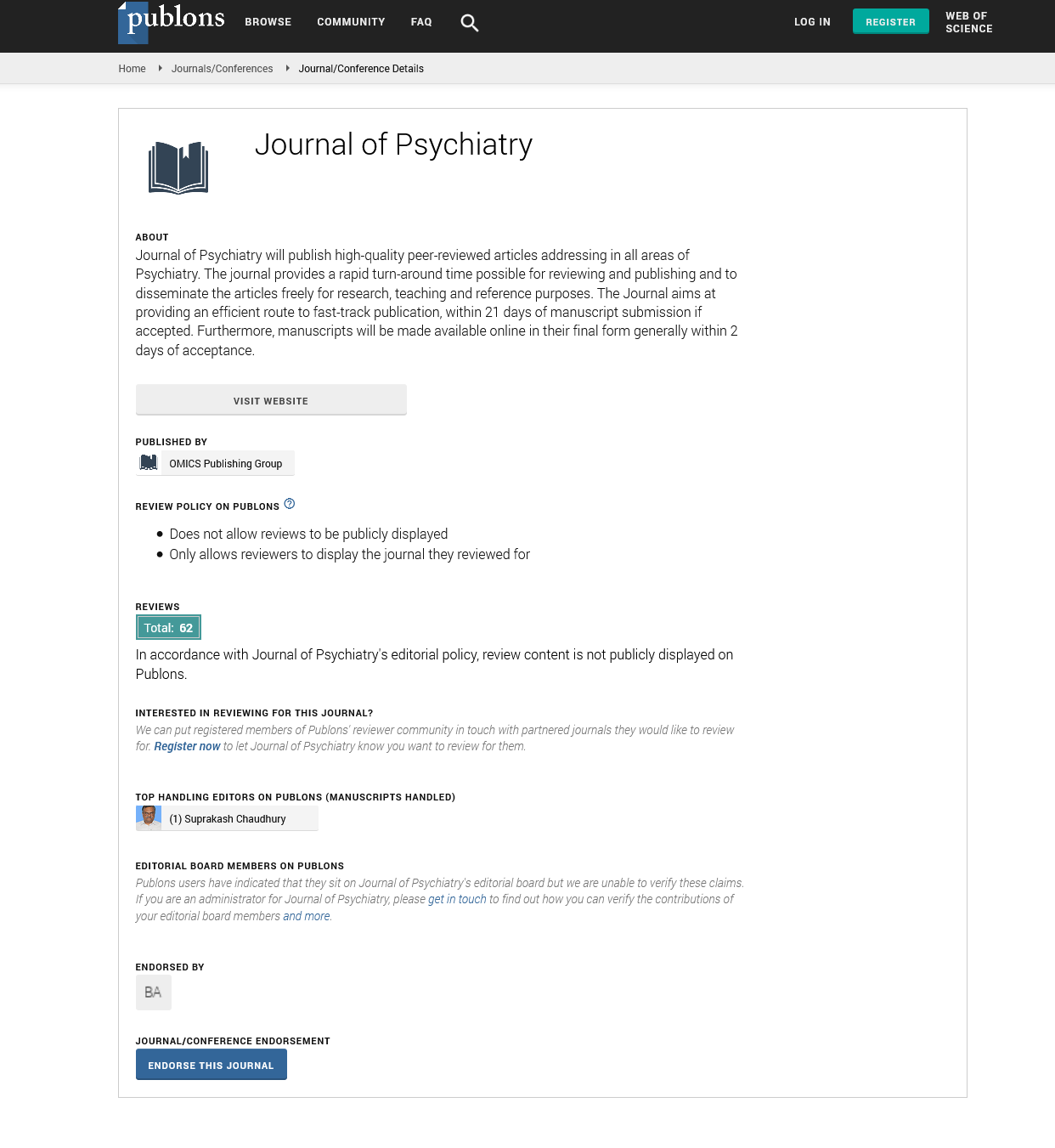Indexed In
- RefSeek
- Hamdard University
- EBSCO A-Z
- OCLC- WorldCat
- SWB online catalog
- Publons
- International committee of medical journals editors (ICMJE)
- Geneva Foundation for Medical Education and Research
Useful Links
Share This Page
Open Access Journals
- Agri and Aquaculture
- Biochemistry
- Bioinformatics & Systems Biology
- Business & Management
- Chemistry
- Clinical Sciences
- Engineering
- Food & Nutrition
- General Science
- Genetics & Molecular Biology
- Immunology & Microbiology
- Medical Sciences
- Neuroscience & Psychology
- Nursing & Health Care
- Pharmaceutical Sciences
Opinion - (2023) Volume 26, Issue 6
The Impact of Stress and Trauma on Neurocognitive Processes in Post-Traumatic Stress Disorder
Sahar Papanas*Received: 02-Jun-2023, Manuscript No. JOP-23-21935; Editor assigned: 05-Jun-2023, Pre QC No. JOP-23-21935(PQ); Reviewed: 19-Jun-2023, QC No. JOP-23-21935; Revised: 26-Jun-2023, Manuscript No. JOP-23-21935(R); Published: 03-Jul-2023, DOI: 10.35248/2378-5756.23.26.605
Description
Post-Traumatic Stress Disorder (PTSD) is a mental health condition that develops after experiencing or witnessing a traumatic event, such as abuse, violence, or a natural disaster. PTSD is characterized by persistent and intrusive memories of the trauma, avoidance of trauma-related stimuli, negative changes in mood and cognition, and increased arousal and reactivity. PTSD can impair one's daily functioning, interpersonal relationships, and quality of life. While alterations in behavior are the hallmarks of PTSD, the causes for these changes involve changes to significant brain structures. One study using Functional Magnetic Resonance Imaging (fMRI) showed that brain structure and function might underlie the symptoms of post-traumatic stress disorder. In this article, we will review some of the main effects of stress and trauma on the brain, focusing on three regions: the amygdala, the hippocampus, and the prefrontal cortex.
Amygdala
The amygdala is a small almond-shaped structure located in the medial temporal lobe of the brain. It is involved in processing emotions, especially fear and anger, and attaching emotional significance to sensory stimuli. The amygdala also plays a role in activating the Hypothalamic-Pituitary-Adrenal (HPA) axis, which is the main stress response system in the body. Trauma can alter the structure and function of the amygdala in several ways. First, trauma can increase the size and activity of the amygdala, making it more sensitive to threat cues and more prone to generate fear responses. Second, trauma can impair the connectivity between the amygdala and other brain regions, such as the hippocampus and the prefrontal cortex, which are involved in memory consolidation and regulation of emotions. Third, trauma can disrupt the balance between the two hemispheres of the amygdala, which have different roles in processing positive and negative emotions. These changes in the amygdala can contribute to several symptoms of PTSD, such as hyperarousal, hyper vigilance, flashbacks, nightmares, and exaggerated startle response.
The hippocampus
The hippocampus is a curved structure located in the medial temporal lobe of the brain. It is responsible for forming, storing, and retrieving memories, especially autobiographical and spatial memories. The hippocampus also plays a role in contextualizing sensory stimuli and regulating the HPA axis. Trauma can alter the structure and function of the hippocampus in several ways. First, trauma can decrease the volume and activity of the hippocampus, making it more vulnerable to damage by stress hormones. Second, trauma can impair the neurogenesis (the formation of new neurons) in the dentate gyrus of the hippocampus, which is important for learning and memory. Third, trauma can affect the connectivity between the hippocampus and other brain regions, such as the amygdala and the prefrontal cortex, which are involved in emotional processing and executive functions. These changes in the hippocampus can contribute to several symptoms of PTSD, such as impaired memory consolidation, dissociation, depersonalization, derealization, and difficulty in distinguishing past from present.
The prefrontal cortex
The prefrontal cortex is a large region located in the anterior part of the frontal lobe of the brain. It is involved in higher cognitive functions, such as attention, planning, decisionmaking, problem-solving, working memory, impulse control, and social cognition. The prefrontal cortex also plays a role in modulating emotions and inhibiting inappropriate behaviors. Trauma can alter the structure and function of the prefrontal cortex in several ways. First, trauma can decrease the volume and activity of the prefrontal cortex, making it less efficient and more susceptible to interference by stress hormones. Second, trauma can impair the connectivity between the prefrontal cortex and other brain regions, such as the amygdala and the hippocampus, which are involved in emotional regulation and memory integration. Third, trauma can affect the lateralization of the prefrontal cortex, which has different roles in processing positive and negative emotions. These changes in the prefrontal cortex can contribute to several symptoms of PTSD, such as impaired executive functions, poor judgment, and reduced attention span, difficulty in concentrating, emotional numbing, and loss of interest.
Stress and trauma can have profound and lasting effects on the brain structure and function, especially in the amygdala, the hippocampus, and the prefrontal cortex. These changes can underlie the symptoms of PTSD and interfere with one's daily functioning and well-being. However, the brain also has the capacity to adapt and heal from trauma, through neuroplasticity and neurogenesis. Various interventions, such as psychotherapy, pharmacotherapy, and Neuro feedback, can help restore the brain's balance and promote recovery from PTSD.
Citation: Papanas S (2023) The Impact of Stress and Trauma on Neurocognitive Processes in Post-Traumatic Stress Disorder. J Psychiatry. 26:605.
Copyright: © 2023 Papanas S . This is an open access article distributed under the terms of the Creative Commons Attribution License, which permits unrestricted use, distribution, and reproduction in any medium, provided the original author and source are credited.

